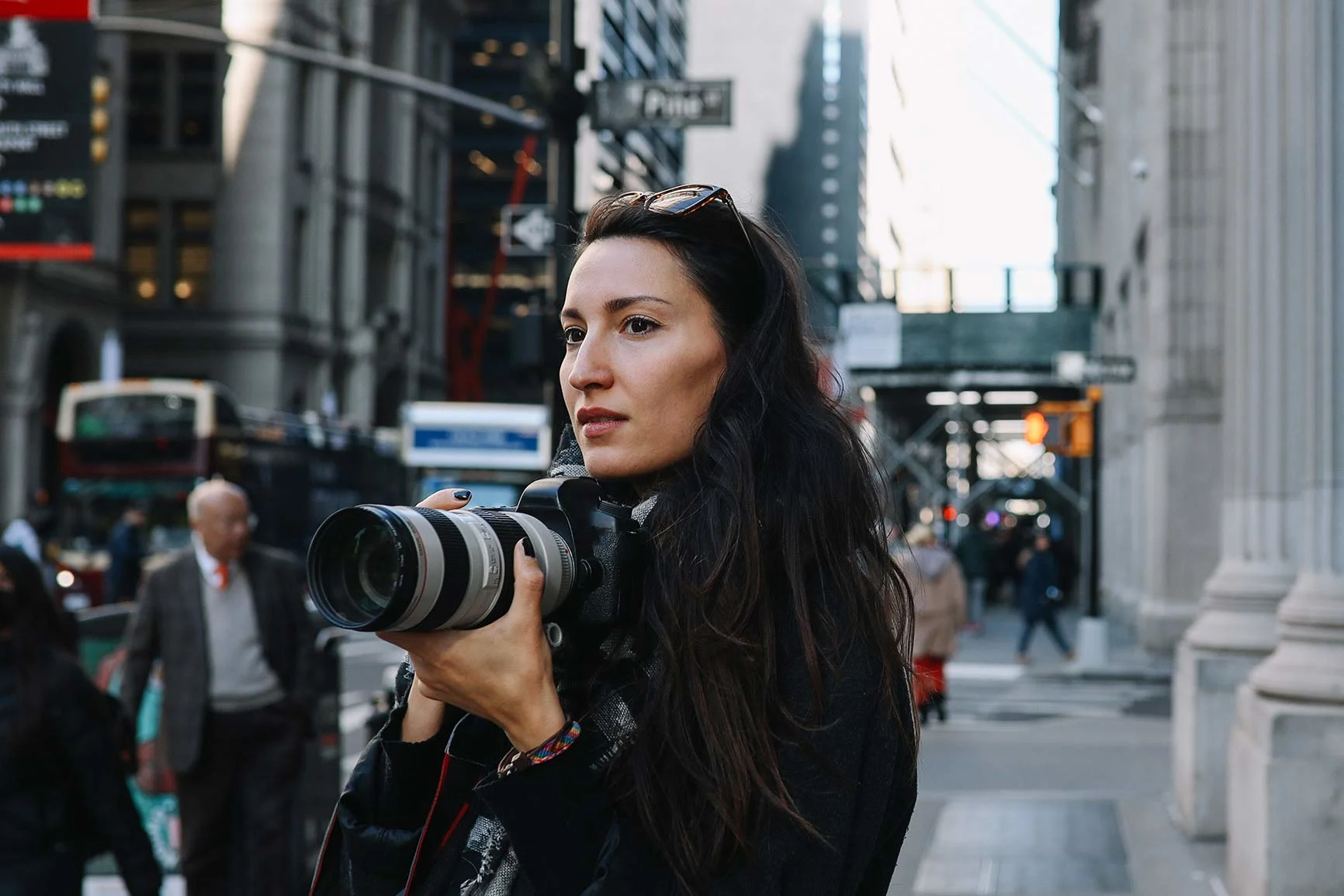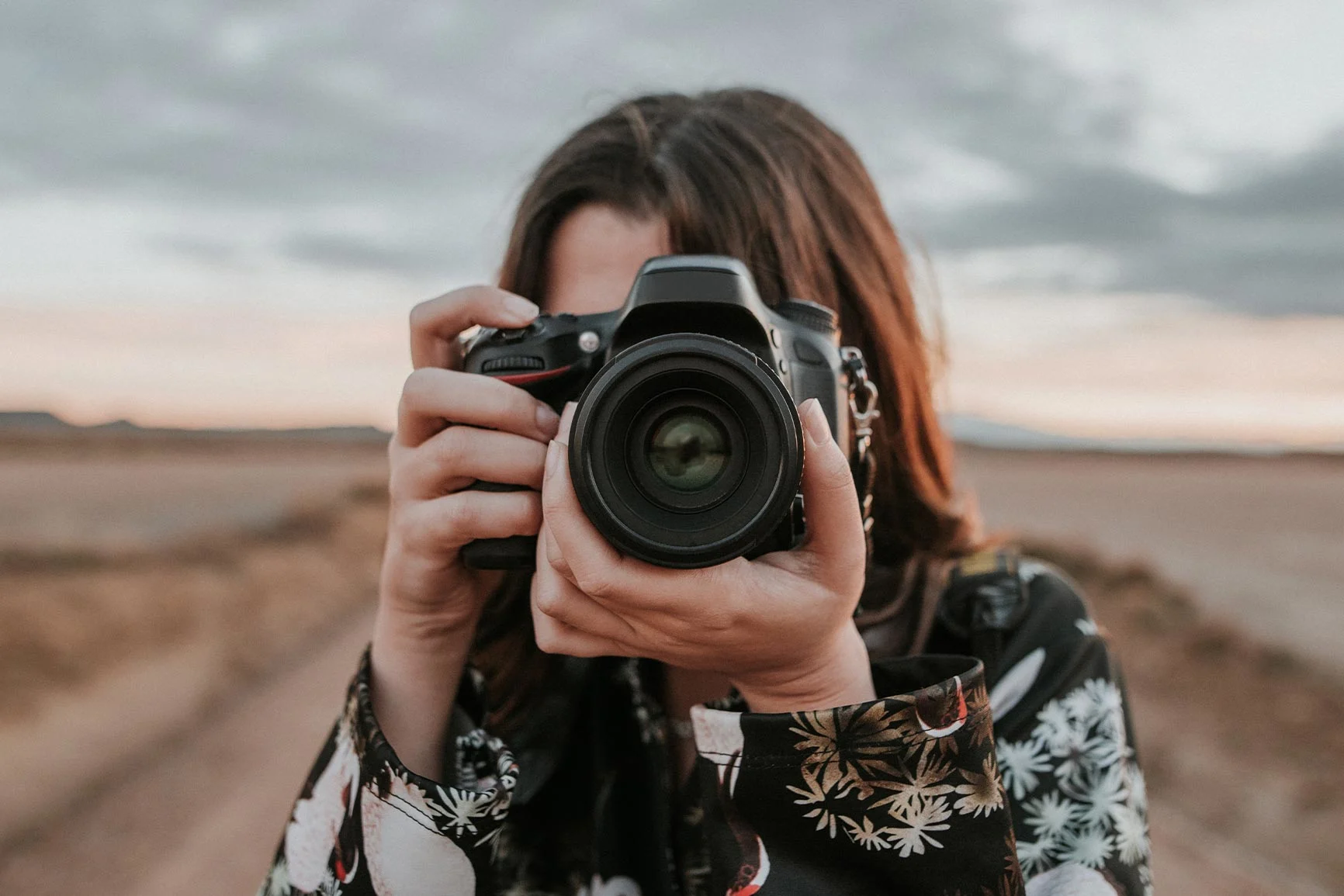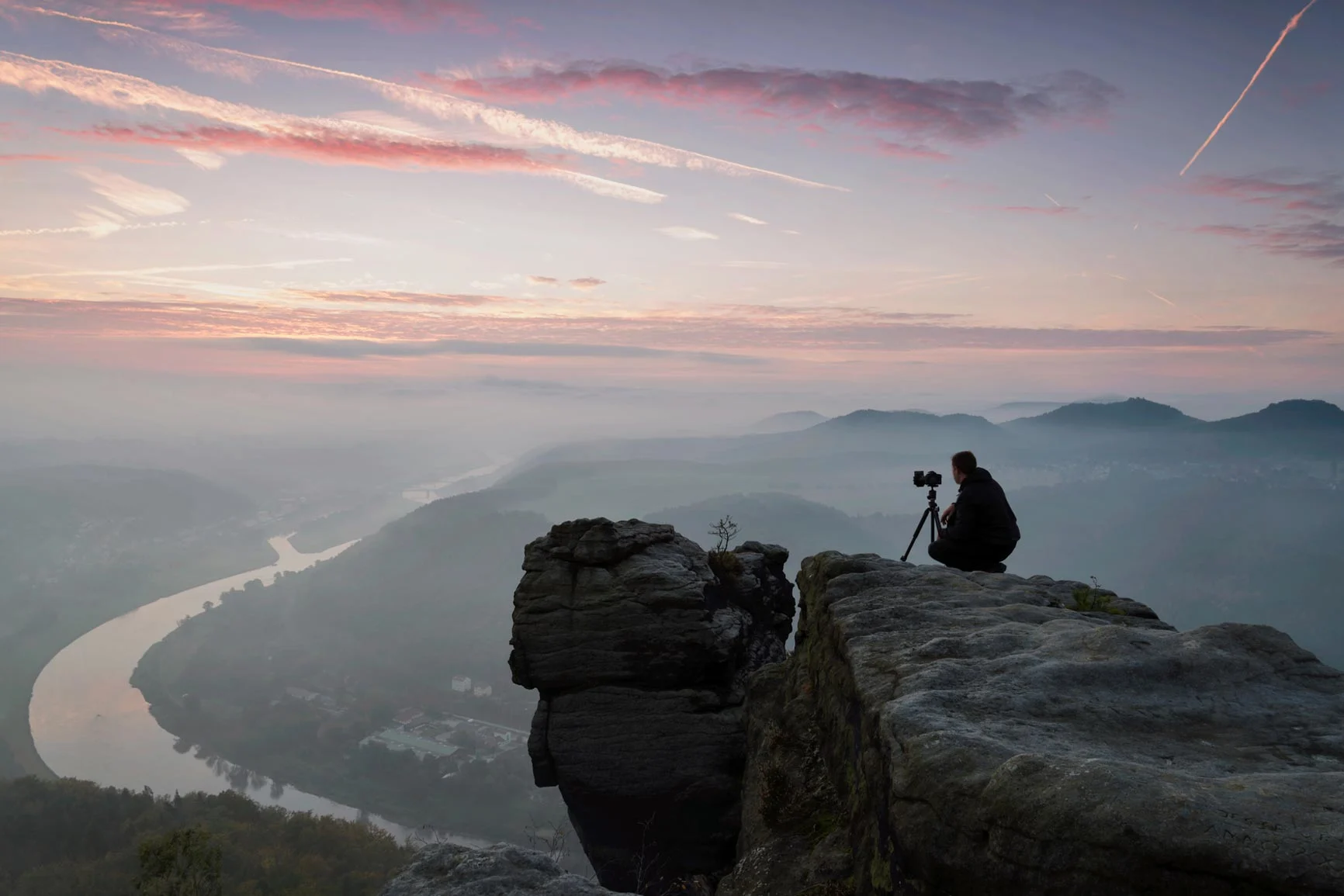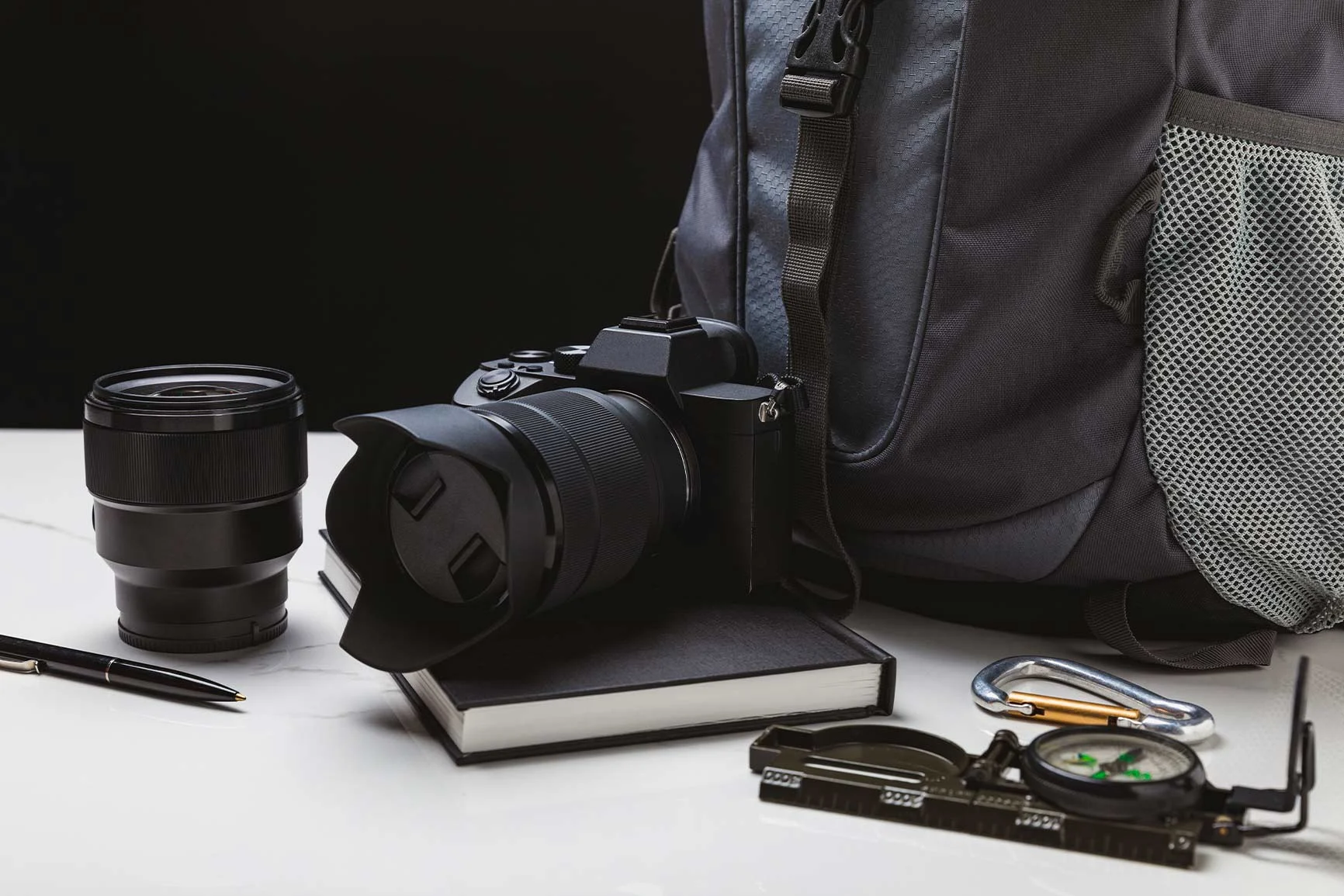Photo equipment when traveling: Tips and recommendations for photographers
From WhiteWall expert Katharina Wergen
Travel and photography are inextricably linked. Every journey offers unique subjects – from vast landscapes and vibrant cities to special encounters with foreign cultures. The right photography equipment is key to capturing these experiences in impressive quality.
For photographers, putting together the right camera gear presents a special challenge. Mobility and flexibility are crucial. Whether compact camera systems, versatile lenses or well-thought-out accessories – every piece of equipment contributes to creating unforgettable memories. This article provides a comprehensive guide on how photographers can optimally assemble their equipment.
The camera: the heart of travel photography
Mirrorless cameras as ideal travel companions
Mirrorless cameras have become the go-to choice for travel photographers in recent years. They often offer good to excellent image quality and, thanks to the lack of a mirror mechanism, are generally more compact and lightweight than traditional DSLRs. Like DSLRs, mirrorless system cameras (DSLMs) combine powerful sensors with the ability to use interchangeable lenses. This allows DSLMs to capture a wide variety of subjects – from landscapes to portraits to action shots – in high quality.
Another advantage of mirrorless systems over DSLRs is their advanced technology, often including features such as an electronic viewfinder, in-body image stabilization, and enhanced autofocus options. These features make it easier to shoot in challenging situations, such as low-light conditions or busy environments. At the same time, they offer image quality comparable to DSLRs in a much more compact format.

High-end compact cameras on the go
Compact cameras are playing an increasingly smaller role, as smartphones have taken over many of their functions. Nevertheless, there are high-end models that deliver excellent image quality in a very handy format. The Fujifilm X100 VI with a fixed 23 mm lens and the Leica Q3 with a full-frame sensor are examples of cameras that stand out from smartphones in terms of robustness and performance. They are ideal for minimalist photographers who don’t want to change lenses but don’t want to compromise on quality.
Smartphones as an alternative
Smartphones have revolutionized travel photography and offer a convenient alternative to traditional cameras. With their advanced camera systems and AI-supported features, they deliver impressive results, especially in good lighting conditions. They are perfect for spontaneous shots and snapshots, as they are always at hand and offer versatile features like night modes or automatic editing. However, when it comes to capturing fine details, shooting in low light, or achieving natural bokeh, smartphones reach their limits. This is where system cameras with larger sensors and high-quality lenses excel.
Criteria for choosing a travel camera
When choosing the right camera for a trip, various criteria must be considered, both in terms of technical performance and practical handling. One important factor is the camera’s weight. Lightweight and compact models are ideal, as they enhance comfort on long journeys and don’t add unnecessary weight to your luggage. Especially on multi-day hikes or extended city tours, a lightweight camera setup proves to be a great advantage.
Robustness is another key factor. Cameras with weather-sealed bodies offer protection from dust, rain, and extreme temperatures. They are especially suitable for outdoor activities, where the gear is often exposed to harsh conditions. A robust camera ensures that you can keep shooting in adverse environments without damaging the equipment.
Image quality plays a central role and is influenced by factors such as resolution, color depth, and dynamic range. Cameras with larger sensors like APS-C or full-frame sensors perform better in low light, produce more detailed images, and deliver more natural color reproduction. Additionally, a larger sensor creates a shallower depth of field, which is particularly advantageous for portrait photography with a blurred background.
Another aspect is ease of use. An intuitive menu structure, easily accessible controls, and the ability to save custom settings greatly facilitate working with the camera. Modern features like fast autofocus or a tilting screen are also helpful for quickly adapting to different situations.
Specialty cameras for unique shots
In addition to traditional camera systems, there are specialty cameras that serve specific purposes while traveling. Action cameras are compact, rugged, and often waterproof, making them ideal for sports activities or underwater photography. Drones offer completely new perspectives by capturing aerial views of landscapes, cities, or events. They are especially appealing to photographers and videographers who value spectacular and unusual viewpoints. However, it is essential to check local regulations before flying drones, as their use is prohibited in some national parks and certain locations.
360-degree cameras, on the other hand, offer the ability to create immersive panoramas that allow viewers to dive into the scene. These cameras are excellent for documenting travel experiences or creative virtual reality projects.

Product tip: Those who want to stylishly present their best travel photos afterward will find premium print solutions at WhiteWall. Fine Art Prints as well as mountings on aluminum Dibond or behind acrylic glass showcase travel photos in the best possible light and turn them into lasting highlights at home. With the WhiteWall Coffee Table Book, the journey can also be relived in images you can flip through.
Lenses: Flexibility and Versatility
Choosing the right lenses is just as important for travel photography as selecting the camera itself. Lenses determine how flexibly you can respond to different subjects and influence both image quality and the style of photography. The challenge lies in selecting a versatile range that meets the demands of the trip without taking up too much weight or space.
Zoom lenses
Zoom lenses are often the first choice for travel photography because they cover a wide focal length range, allowing you to capture a variety of subjects – from landscapes and architecture to portraits and distant details – with just one lens. Standard zooms with focal lengths of around 24–70 mm or 24–105 mm offer a good balance between wide angle and light telephoto. They are ideal for covering a wide range of scenarios without needing to change lenses. Wide-angle zooms between 16 and 35 mm are particularly suitable for sweeping landscape shots or impressive architectural interiors. Telephoto zooms like 70–200 mm or 100–300 mm allow you to get close to distant subjects like animals or architectural details.
Some standard zoom lenses feature a mechanism that allows the lens body to retract when not in use. These models can be compactly stowed in the camera bag and are only extended when shooting. This saves valuable luggage space and helps organize gear more efficiently.

Prime lenses
Prime lenses often offer better image quality and greater light sensitivity than zoom lenses. Focal lengths of 35 mm or 50 mm are excellent for portraits and travel reports, as they provide a natural perspective. The higher light sensitivity of many prime lenses allows for photography in low light or the creation of attractive bokeh, where the background appears soft and out of focus. However, it’s important to note that especially with full-frame cameras, fast lenses with large maximum apertures are often heavier and bulkier due to their larger diameter glass.
Light sensitivity
Light sensitivity is another key factor when choosing a lens. Lenses with large maximum apertures, such as f/1.4 or f/2.8, let more light reach the sensor, which is advantageous in low-light conditions or for creative effects like shallow depth of field. These fast lenses allow for shorter shutter speeds and lower ISO settings, resulting in clearer and more detailed images. The downside is that such lenses tend to be larger, heavier, and more expensive. For travel photography, where mobility is important, less light-sensitive but more compact lenses can be a practical alternative. Lenses with maximum apertures of f/4 or f/5.6 offer a good compromise between sufficient light sensitivity and compact design.
How many lenses do you need?
The decision to carry one or several lenses depends largely on the subjects that will be prioritized during the trip. Landscape photographers benefit from wide-angle zooms, while telephoto lenses are essential for wildlife and action photography. Those focusing on portraits and reports are well served with fast prime lenses. Many travel photographers prefer the standard zoom as the ideal all-rounder for various subjects.
Accessories: Practical helpers on the go
The right accessories complete the travel photography kit and make it easier to shoot in different situations. Accessories such as tripods, filters, chargers, or storage media help improve workflow efficiency and image quality.
Tripods
A tripod is an essential tool for travel photographers, especially for long exposures, night shots, or group photos. Special travel tripods are characterized by a small pack size – they can be folded down to a compact format for easy storage in luggage. Many travel tripods also offer additional functions, such as the ability to convert into a monopod, which can be handy in tight spaces. Spikes for a secure grip on soft or slippery surfaces are often included. This versatility makes travel tripods highly adaptable, whether in urban environments, on rugged hiking trails, or at the beach.

Filters for creative shots
Filters expand creative possibilities. ND filters (neutral density filters) are particularly useful for extending exposure times. With their help, impressive effects can be achieved, such as depicting water as a soft, flowing motion in long exposures during the day. They are also excellent for exposing busy places or heavily trafficked streets long enough that hardly any people or vehicles remain visible in the image.
Polarizing filters reduce reflections on glass or water surfaces while intensifying colors – especially in landscape photography. These filters are great for making skies appear more dramatic or minimizing reflections on lakes.
Chargers, power banks, and power supply
A reliable power supply is essential when traveling, especially on longer trips or in remote regions. High-capacity power banks provide a practical way to charge your camera, smartphone, or other devices on the go. It’s particularly helpful if the camera can be charged directly via USB, eliminating the need for additional charging units.
Travel adapters are also important to adapt to different socket systems in various countries. Some models come with extra USB ports, allowing multiple devices to be charged simultaneously. These small helpers ensure your gear is always ready for action.
Memory cards and data backup
When it comes to memory cards, it makes sense to bring several medium-sized cards of about 64 GB each instead of one large card of 128 GB or more. If a card is damaged or stolen, fewer shots are lost. Cameras with dual card slots offer extra security, as photos and videos can be stored simultaneously on both cards. This backup option protects against data loss and provides an easy way to duplicate your files.
External SSD drives are another method of backing up photos and videos on the go. Nowadays, many lightweight, compact, and durable SSDs are available for mobile use. They allow you to back up memory cards while freeing up space on the cards themselves.
Backups with tablets or small notebooks
Tablets or small laptops are suitable for backing up memory cards, as they are easy to carry and can be connected to a card reader and an external SSD. This enables regular file copies and adds an extra layer of security. Tablets and notebooks also facilitate photo editing on the go, allowing you to review or enhance first results directly.
Protection and transport: Staying safe on the move
Protecting and safely transporting photography gear is essential to prevent damage or theft. Especially when traveling in various environments and weather conditions, well-thought-out transport solutions are crucial.
Camera bags and backpacks
Camera bags and backpacks are the first choice for safely transporting photo equipment. Good padding is vital to protect sensitive cameras and lenses from damage. It’s particularly important that the padding is strong not only on the sides but also on the bottom to protect gear from shocks or drops.
For additional theft protection, some bags offer built-in security locks or larger loops to secure zippers with a small padlock. This is especially useful in crowded urban environments where pickpockets may be a risk.
Flexibility is another key factor. Modern camera bags and backpacks often allow tripods to be attached externally. Many backpacks also provide enough space for additional items such as water bottles, snacks, or spare clothing. Especially convenient are daypacks that divide the interior into two separate compartments: the bottom section holds camera gear securely, while the top section is reserved for personal items – ideal for day trips or hikes.

Protection from rain, sand, and moisture
Protecting equipment from the elements is an important factor when traveling. Many camera bags come with a built-in rain cover that protects gear from light rain. For harsher conditions like heavy rain or sandy environments, fully waterproof bags are available. These can even be submerged in water, making them ideal for adventure travel or use in tropical climates.
A more affordable alternative is waterproof sleeves that can be pulled over the camera bag. These sleeves, often found in outdoor gear shops, provide effective protection from rain, sand, and moisture and can be deployed quickly when needed.
Carry-on or checked luggage?
Photo equipment should always be carried in hand luggage if possible. This ensures it is readily accessible and protected from rough handling or theft.
Larger items such as tripods are often stowed in checked baggage due to space constraints. To prevent damage, they should be transported in hard cases and additionally cushioned with clothing or padding material.
Conclusion
Choosing the right photography gear for travel is essential to capture special moments in the best possible quality. A carefully assembled kit of a compact camera, versatile lenses, practical accessories, and well-designed transport solutions allows you to adapt flexibly to different situations and subjects. At the same time, various safety and protection measures offer peace of mind that your valuable gear is well protected on the go.
Whether it’s selecting a compact travel tripod, using ND filters for creative long exposures, or securing backups with external SSDs – every detail contributes to making travel photography a smooth and inspiring experience.
Product Tip: The best travel photos deserve high-quality presentation. Fine Art Prints or acrylic-mounted photos preserve unique memories in gallery quality and showcase them impressively. With customized solutions from WhiteWall, every journey becomes a lasting story that can be relived again and again.
Learn more about the author
As a trained portrait and wedding photographer, Katharina Wergen brings her extensive knowledge to photography. She has been working as a sales consultant at WhiteWall since 2018 and supports exhibition projects for museums and galleries. She is also increasingly focusing on reportage photography. Take a look behind the scenes of the photographer, here in the interview.

Also interesting:
Submitted by WhiteWall expert Katharina Wergen
Material & motif recommendations – How to take impressive travel photos
Learn how to create unforgettable travel photos with careful planning, the right equipment, and creative ideas. Whether nature, city, or culture—this guide offers inspiration and practical tips for impressive motifs and the perfect image presentation.
Submitted by WhiteWall expert Katharina Wergen
Top spots for photographers worldwide
Discover the most beautiful photo spots in Europe – with tips on motifs, lighting, and image composition. Ideal for travel and landscape photography.
Submitted by WhiteWall expert Katharina Wergen
Top spots for photographers in America – contrasts, vastness, and iconic images
Discover America's most fascinating photo spots – from the icy peaks of Canada to the iconic national parks of the USA, the colorful streets of Mexico, and the tropics of the Caribbean. Be inspired and find motifs for unforgettable shots.




